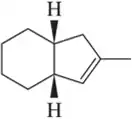Predict the product(s) that would result when the alkenes are allowed to react under the following conditions: (iv) Cl2, CH3OH
(d)

 Verified step by step guidance
Verified step by step guidance Verified video answer for a similar problem:
Verified video answer for a similar problem:



 1:44m
1:44mMaster General properties of halohydrin formation. with a bite sized video explanation from Johnny
Start learning